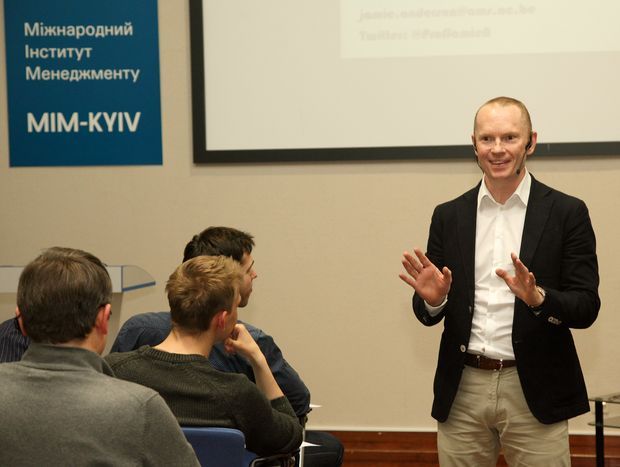On creativity, innovation, and… not a word about Lady Gaga!
Professor Jamie Anderson, the world-famous author of Gaganomics: a full-house master class at MIM-Kyiv
What is the secret of singer Lady Gaga’s phenomenal commercial success? How come a singer who debuted in 2008 drew an unprecedented income of about 100 million dollars, according to Forbes, as soon as 2011? The answers to these questions should be sought in an innovational business model proposed to Lady Gaga. She achieved a steep rise in her popularity and, hence, incomes by making active use of network communication technologies. Lady Gaga is called “download queen” and “YouTube star.”
It is approximately with these words that Jamie Anderson, a professor at the London Business School and the Zurich-based Lorange Institute of Business, struck the audience of an international conference of business school managers in Nottingham, UK. The academic, whom The Financial Times rated among the top 25 modern management gurus, invited the respected audience to discuss the phenomenon of singer Lady Gaga as an absolutely new opportunity for growth and development which network communication opens to modern-day business.
Astonished by this speech, Iryna TYKHOMYROVA, president of Ukraine’s leading business school MIM-Kyiv, who attended the Nottingham forum, wrote a personal column, “Earning like Lady Gaga. How Social Networking Sites Changed the Business Milieu” (the text is available on MIM-Kyiv’s official website), in the business portal Liga Biznes Inform.
This year Prof. Jamie Anderson came to Ukraine by invitation of MIM-Kyiv to hold a keynote session with our businesspeople and managers. The world-famous strategy, innovations, and creativity guru delivered a report titled “Digital Lady Gaga.” Yet Anderson mentioned the name of Lady Gaga only once during an hour-long session – when he enumerated the “objects” of his research. Instead, the professor told the business audience about innovations in rather a simple and easy way.
In Anderson’s words, innovation is an “easy thing.” “What precedes innovation is far more difficult,” the professor noted at the beginning of the session. The other half of his report was in fact an explanation of creativity, a “difficult thing.”
Anderson began the first part of his lecture with a story about 4,000 years of “innovations” in shaving. The professor explained the topic on the example of Gillette, the world-famous safety razor producer: how and owing to what they superseded the older razor manufacturers, which product was the acme of their inventors, and how they improved it later. “And what would you do if you competed with Gillette? What is to be done to overcome the popularity of their products?” Anderson asked the MIM people.
“I want blades to be flexible,” “and you can insert an MP3 player into the razor,” “or a cell phone,” “or a GPS,” the audience answered with their own creative suggestions.
“This is all interesting, but it seems to me we have stuck like a cork in a bottle. I wish we’d try to think out of the box called ‘face,’” Anderson responded, “for people have hair growing all over the body.”
The professor showed a new product of another company, with which you can shave the whole body, and asked: “What do you think Gillette could do to beat ‘this’?”
“Want to see? The point is that when these guys do some innovations, they send them to me for appraisal. So I received a whole Gillette package three months ago. Want to see? This is a true body ‘Chrysler’ from Gillette – it has everything, not only the blades,” Anderson said, holding a brand-new device in hand.
“Is all that I’ve said an innovation?” Anderson asked the audience after demonstrating a complete set of the razors and blades he had brought to Kyiv. Only a few people said “yes.” The rest called Anderson’s story “evolution of a product,” and they were right. The professor pointed out there is a radical difference between the innovations that improve something, i.e., work for the “evolution” of a product and strategic innovations that in fact create a new market.
As a matter of fact, in the words of Prof. Anderson, the creation of innovations, which is taught in business schools, is a very simple process, “clear even to an ape.” The strategic innovations are “new who?”, “new what?”, “new in what way?”, and “new where to?” The answers to these four questions in fact comprise all that one must know about the innovation creation process.
But, to create a really new product, you need creativity rather than this. “If you can be a creative person, you can also create innovations,” Prof. Anderson says.
In the next 30 minutes, the creativity guru taught businesspeople to create and… think.
“You don’t need to waste time on why you can’t do this, you’d better use your time to think how to do this,” Anderson advised.
As the lecture drew to a close, the professor advised in the best traditions of Hollywood “showmen.” It turns out that, to be the author of an innovation (read: a successful businessperson), you should ponder over what and how you want to do, and, to have enough creative drive to do so, you need two substances – dopamine and oxytocin – which psychologists call hormones of feelings and emotions. It is quite easy to acquire these hormones by means of sport, chocolate, sex, and… hugging seven people every day.






